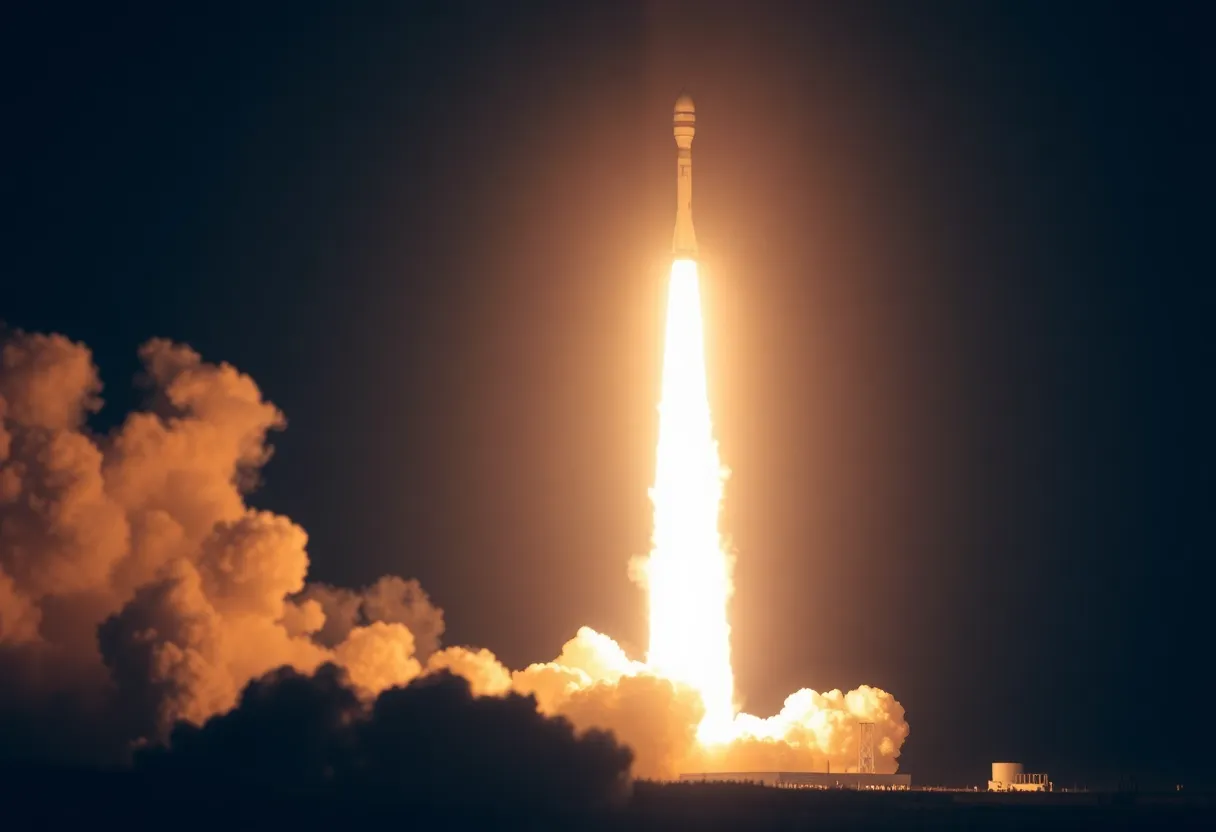News Summary
United Launch Alliance has achieved a milestone in space exploration with the successful launch of its first fully operational Vulcan rocket. The launch, which took place at Cape Canaveral Space Force Station, marked the inaugural flight certified by Space Force to carry national security payloads. The Vulcan rocket, equipped with advanced technology and capable of significant thrust, aims to enhance capabilities for military navigation efforts through the deployment of critical satellites. This mission is pivotal for future military space operations, as ULA plans to ramp up its launch activities in the coming years.
Florida — United Launch Alliance (ULA) achieved a significant milestone in space exploration with the successful launch of its first fully operational Vulcan rocket on August 12, 2025, at 8:56 p.m. EDT. The launch took place from pad 41 at the Cape Canaveral Space Force Station and marked the first Space Force-sanctioned flight of the Vulcan, which is set to replace ULA’s Atlas 5 and retired Delta rockets.
The Vulcan rocket measures 198 feet in height and boasts four solid-fuel strap-on boosters, supported by two methane-fueled BE-4 engines. At liftoff, the rocket generated nearly 3 million pounds of thrust, producing a visible exhaust trail that extended for miles across the sky. Approximately 90 seconds after takeoff, the four strap-on boosters were detached, followed by the separation of the first stage, which stands at 109 feet, three-and-a-half minutes post-launch. The longest phase of the flight began when the Centaur second stage ignited using two hydrogen-fueled Aerojet Rocketdyne RL10C engines. Following standard military protocol, ULA ceased its launch commentary after the first stage’s separation, and the remaining flight operations proceeded under secrecy.
The payload encompassing this historic launch included at least two military satellites: one classified spacecraft and the experimental Navigation Technology Satellite 3 (NTS-3). NTS-3 aims to enhance Global Positioning System (GPS) capabilities for military and commercial users by testing upgraded atomic clocks and navigation technologies. The satellites are headed toward a geosynchronous orbit at approximately 22,300 miles above the equator, allowing them to maintain a constant position relative to the Earth. NTS-3 is further equipped with an advanced phased array antenna that facilitates electronic signal direction across extensive regions.
This mission is significant as it represents the Pentagon’s inaugural consideration of an experimental navigation satellite since the original GPS precursors in the 1970s. NTS-3 was developed by L3Harris Technologies and is linked to a ground-based control system that enables rapid software updates, ensuring its adaptability to evolving navigation demands.
This launch was also notable as it served as the third flight for the Vulcan rocket, following two test missions conducted in the previous year. Furthermore, it held the distinction of being the first launch certified by the Space Force to transport national security payloads, including spy satellites. According to ULA, this mission was crafted with direct injection to a geosynchronous orbit in mind, rendering it one of ULA’s longest missions to date.
In the background, it is worth noting that the Vulcan rocket’s development stems from the necessity to replace ULA’s retired Delta rockets and the Atlas 5, which has been criticized for its dependency on Russian-built RD-180 engines. Currently, ULA holds thirteen Atlas 5 rockets in its inventory, all designated for civilian missions, while the company progresses toward establishing a fully operational Vulcan fleet.
Industry estimates indicate that SpaceX’s Falcon 9 rocket has completed 97 launches in 2025, maintaining a strong hold on the commercial launch market. ULA’s CEO highlighted the Vulcan rocket’s design advantages for military payloads, emphasizing its unique capability to access specialized orbits that may not be easily reached by other launch vehicles. The Vulcan’s operational efficiency is enhanced as it can function with one core engine, in contrast to typical three-core heavy launch systems.
Looking ahead, ULA plans to expand its ground infrastructure support and aims to conduct nine launches throughout 2025, eventually ramping up to two launches per month by the year’s end. The company anticipates executing between 20 to 25 flights in 2026 as part of its strategic future mission objectives.
Deeper Dive: News & Info About This Topic
- MSN News
- Wikipedia: United Launch Alliance
- SpaceFlight Now
- Google Search: Vulcan rocket launch
- Space.com
- Encyclopedia Britannica: Vulcan rocket
- CBS News
- Google Scholar: Vulcan rocket

Author: STAFF HERE PETERSBURG WRITER
The ST PETERSBURG STAFF WRITER represents the experienced team at HEREStPetersburg.com, your go-to source for actionable local news and information in St Petersburg, Pinellas County, and beyond. Specializing in "news you can use," we cover essential topics like product reviews for personal and business needs, local business directories, politics, real estate trends, neighborhood insights, and state news affecting the area—with deep expertise drawn from years of dedicated reporting and strong community input, including local press releases and business updates. We deliver top reporting on high-value events such as Grand Prix of St. Petersburg, Localtopia, and SHINE Mural Festival. Our coverage extends to key organizations like the St. Petersburg Area Chamber of Commerce and St. Pete Downtown Partnership, plus leading businesses in finance, manufacturing, and healthcare that power the local economy such as Raymond James Financial, Jabil, and Bayfront Health St. Petersburg. As part of the broader HERE network, including HEREJacksonville.com, HEREOrlando.com, HERETallahassee.com, and HERETampa.com, we provide comprehensive, credible insights into Florida's dynamic landscape.





